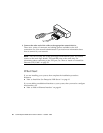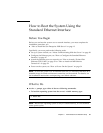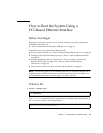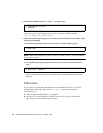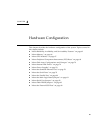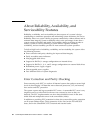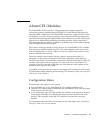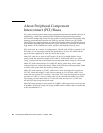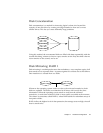
64 Sun Enterprise 220R Server Owner’s Guide • October 1999
Power Supply Redundancy
The system can accommodate one or two power supplies. All system configurations
can operate with only one power supply installed. A second supply can be used to
provide redundancy, allowing the system to continue operating should one of the
power supplies fail.
For more information about power supplies, redundancy, and configuration rules,
see “About Power Supplies” on page 76.
Hot-Swappable Power Supplies
Power supplies in a redundant configuration feature a hot-swap capability. A
qualified service provider can remove and replace a faulty power supply without
turning off the system power, or even shutting down the operating system. The
power supplies are easily accessed from the front of the system. For information
about removing and installing a power supply, see the Sun Enterprise 220R Server
Service Manual.
Four Levels of Diagnostics
For enhanced serviceability and availability, the system provides four different levels
of diagnostic testing: power-on self-test (POST), OpenBoot diagnostics (OBDiag),
SunVTS™, and Sun Enterprise SyMON™.
POST and OBDiag are firmware-resident diagnostics that can run even if the server
is unable to boot the operating system. Application-level diagnostics, such as
SunVTS and Sun Enterprise SyMON, offer additional troubleshooting capabilities
once the operating system is running.
POST diagnostics provide a quick but thorough check of the most basic hardware
functions of the system. For more information about POST, see “About Power-On
Self-Test (POST) Diagnostics” on page 120 and “How to Use POST Diagnostics” on
page 121.
OBDiag diagnostics provide a more comprehensive test of the system, including
external interfaces. OBDiag is described in “About OpenBoot Diagnostics (OBDiag)”
on page 126 and “How to Use OpenBoot Diagnostics (OBDiag)” on page 129.



